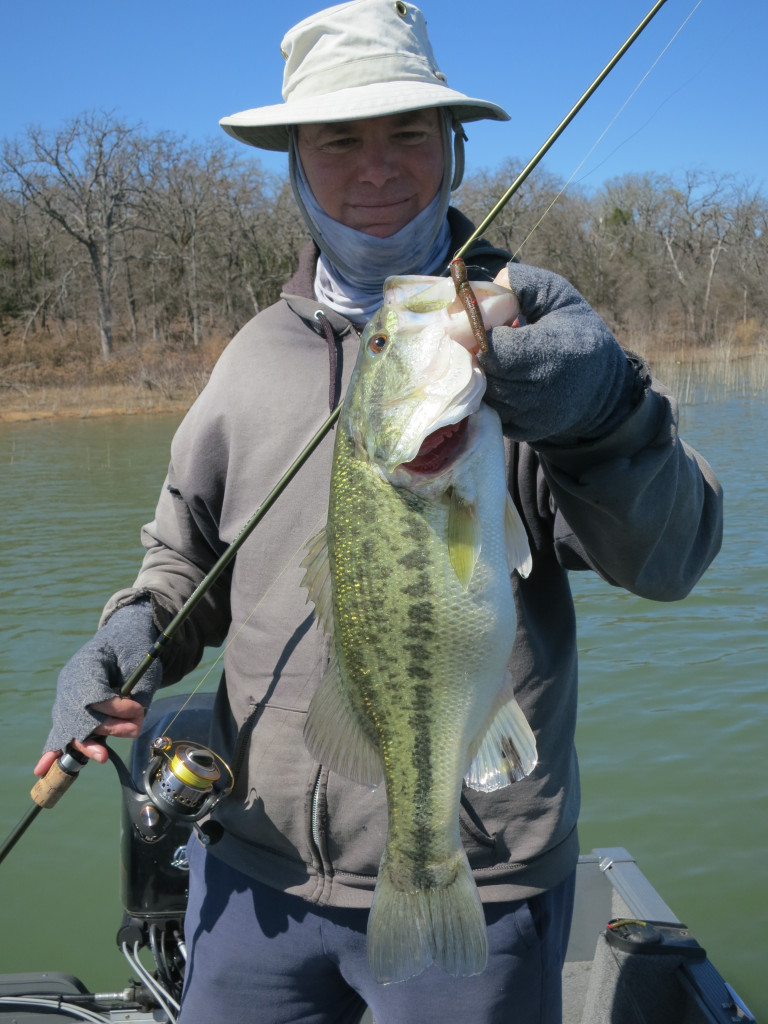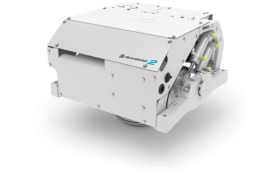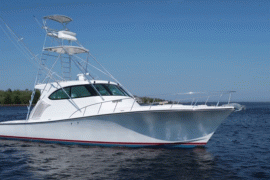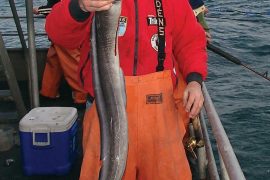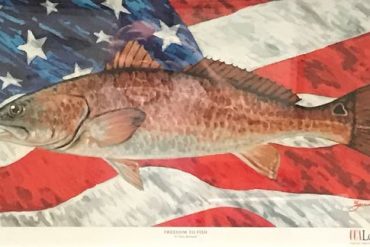Our March guide to Midwest finesse fishing contains 24 logs and 23,049 words that explain how, when, and where Midwest finesse anglers fished. It features the piscatorial efforts of Rick Allen of Dallas; Linda Allen of Dallas; Ted Becharas of San Diego; Matt Boldra of Conifer, Colorado; Norman Brown of Lewisville, Texas; Paul Finn of Olathe, Kansas; Merit Goodman of Eudora, Kansas; Bob Gum of Kansas City, Kansas; David Harrison of Lawrence, Kansas; Rick Hebenstreit of Shawnee, Kansas; Thomas Heinen of Topeka, Kansas; Clyde Holscher of Topeka, Kansas; Pok-Chi Lau of Lawrence, Kansas; George Nochta of Santee, California; Mike Poe of Siler City, North Carolina; Steve Reideler of Denton, Texas; Mike Trometer of Plano, Texas; as well as my northeastern Kansas logs.
As always, we are more than thankful that Steve Reideler proof read all of the words. He made them more readable and understandable.
Mar. 2 log
Steve Reideler of Denton, Texas, posted a log on the Finesse News Network about his Mar. 2 outing.
Here is an edited version of his log:
What a splendid late-winter day. The wind had finally died down and was light and variable. The morning was cool and crisp with a low temperature of 41 degrees. The afternoon high rebounded to 66 degrees. The barometric pressure measured 30.48 at 11:00 a.m. and was 30.42 at 4:00 p.m.
I joined Rick Allen of Dallas at one of the U.S. Army Corps of Engineers’ hill-land reservoirs in north-central Texas. As we were entering the state park and driving toward the boat ramp, we stopped for a moment to admire several whitetail deer that were foraging close to the roadway.
According to In-Fisherman’s solunar calendar, the prime fishing periods would occur from 1:23 a.m. to 3:23 a.m., 7:36 a.m. to 9:36 a.m., and 1:49 p.m. to 3:49 p.m. Rick and I fished from 11:30 a.m. to 4:00 p.m.
This reservoir was our most bountiful waterway in 2016, but it has never been a good wintertime venue. In fact, the few black bass anglers who ply this reservoir in January and February hope to catch only one or two black bass during an eight-hour outing, and they would consider those paltry results a successful day. The last time I fished here was on December 7, 2016, and I had to quickly end the outing after my wife, Nancy, called me on my cell phone and informed me that she had fallen and broken her leg in our garage.
On this March 2 outing, Rick and I concentrated our efforts inside two large feeder-creek arms and one main-lake cove. The two feeder creeks are located in the east tributary arm of the reservoir and the main-lake cove is situated on the south end of the west tributary arm.
The first feeder-creek arm was the most fruitful area. It encompasses several coves and secondary points, and a large island. Partially-flooded terrestrial vegetation line many yards of its shoreline.
The water in this feeder creek was stained with about two feet of visibility. The water temperature ranged from 55 to 57 degrees. The water level was at normal pool.
We caught 15 largemouth bass inside this feeder-creek arm. Eight were caught in less than five feet of water from two points that lie at the entrance of two of the coves. Four largemouth bass were caught in six feet of water from a rocky secondary point about halfway inside the creek arm. Two largemouth bass were caught in three feet of water from a secondary point inside one of the coves. One largemouth bass was caught from the north side of the island in three feet of water.
The second feeder-creek arm lies about a mile north of the first one. It also contains several rocky secondary points, a couple of large mud flats, five coves, and several submerged rock ledges that parallel the shoreline in less than five feet of water. Partially-flooded terrestrial vegetation also adorns the water’s edge of several secondary points and large portions of the interior shorelines of the five coves.
The water inside this feeder creek was 57 degrees and stained. The water clarity was about 1 1/2 feet.
This was our least fruitful locale. We caught one largemouth bass from a main-lake point at the mouth of this creek arm. This bass was relating to a thick patch of partially-flooded bushes in three feet of water. We failed to locate any black bass along the submerged rock ledges, three rocky secondary points, or at the mouth of one of the smaller coves.
The water was dingy inside the main-lake cove on the west side of the reservoir; it exhibited about a foot of visibility. The water temperature varied from 56 to 58 degrees. We caught five largemouth bass and one freshwater drum inside this cove. Three of the five largemouth bass were caught along the north shoreline in three to six feet of water. They were abiding next to a couple of patches of partially-flooded terrestrial vegetation that were intertwined with several large submerged boulders. Two of the five largemouth bass and one freshwater drum were caught in three to five feet of water from a clay secondary point on the east side of the cove. They were caught along the outside edges of several partially-flooded bushes.
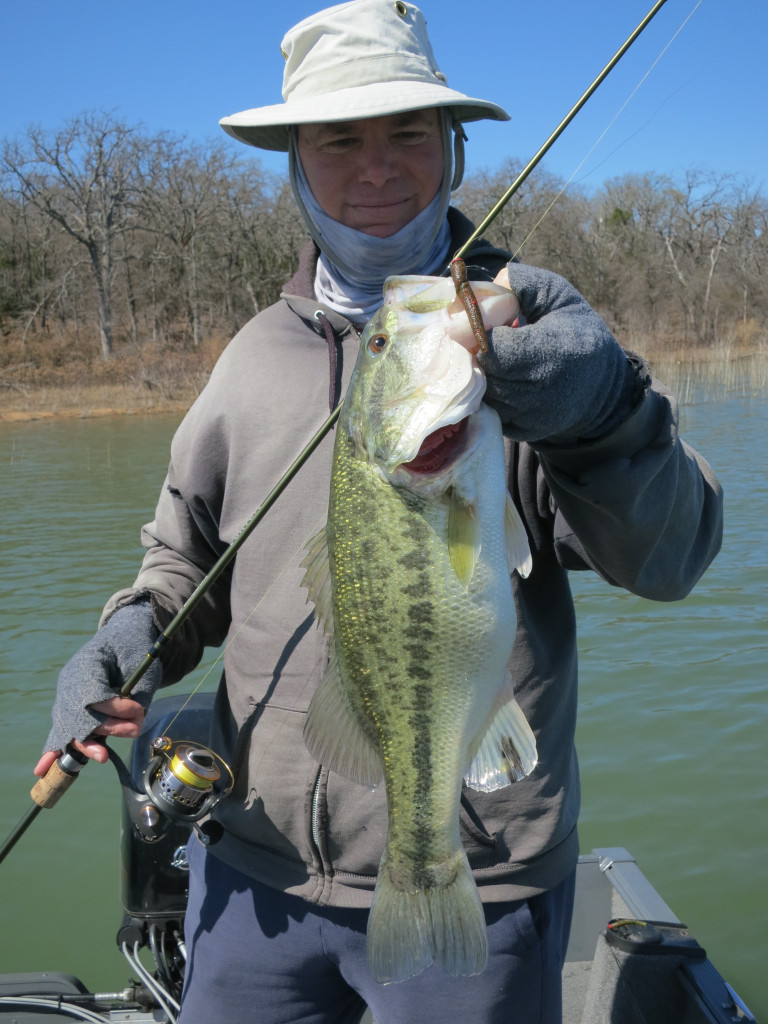
All totaled, we caught 21 largemouth bass in 4 1/2 hours, which is the most black bass that we have ever caught from this reservoir during the month of March. We lost three others that were able to pull free before we could land them, and we elicited several strikes that we failed to hook.
Ten largemouth bass were caught on a 2 1/2-inch Z-Man Fishing Products’ green-pumpkin-red-flake ZinkerZ affixed on a red 1/16-ounce Gopher Tackle’s Mushroom Head jig. A blue 1/16-ounce Gopher jig dressed with a shortened Z-Man’s molting craw Hula StickZ beguiled nine largemouth bass and the freshwater drum. Two largemouth bass were caught on a Z-Man’s green-pumpkin Finesse ShadZ rigged on a red 1/16-ounce Gopher jig.
We experimented with all six of the Midwest finesse retrieves, and a slow swim-glide-and-shake retrieve was the only effective presentation.
Mar. 3 log
Mother Nature’s windy ways kept me and scores of northeastern Kansas anglers at bay on Mar. 1 and 2. To these anglers’ chagrin, she did not relent on Mar. 3, which was a miserable day to be afloat. It, however, gave me an opportunity to work with a new Lindy Fishing Tackle’s 48-inch Magnum Series Drift Sock at one of northeastern Kansas’ community reservoirs, and it worked well. But because of the wind, I had a difficult time keeping my hat from being blown off my bald head. I also had a difficult time finding and catching largemouth bass, and the wind might have had something to do with that struggle.
(I have not written about drift socks since Mar. 1, 2012; see that column at this link: http://www.in-fisherman.com/midwest-finesse/spring-winds-and-drift-socks/. Across the years, we have found them to be an essential and inexpensive tool for helping Midwest finesse anglers to deal with the wind, As the spring of 2017 unfolds, I am hoping to spend some time writing a detailed gear guide for our Midwest Finesse column about drifts socks – especially big drift socks. And this outing was the beginning of this endeavor.)
The Weather Underground reported that it was 19 degrees at 5:52 a.m. and 60 degrees at 3:52 p.m. It was sunny. The wind angled out of the northeast, east by northeast, east by southeast, southeast, and south by southeast at 4 to 28 mph. The barometric pressure was 30.56 at 12:52 a.m., 30.61 at 5:52 a.m., 30.51 at 11:52 a.m., and 30.29 at 3:52 p.m.
The surface temperature ranged from 46 to 49 degrees. The water exhibited two to four feet of visibility. The water level looked to be normal.
In-Fisherman’s solunar calendar indicated that the best fishing would occur from 2:14 a.m. to 4:14 a.m., 2:41 p.m. to 4:41 p.m., and 8:28 a.m. to 10:28 a.m. I fished from 11:00 a.m. to 2:58 p.m., and during those 238 minutes the wind howled at 18 to 25 mph. It was angling out of the southeast, but it was swirling from a multitude of directions, which provoked me to use the drift sock about 90 percent of the time.
At times, I hid from the wind. At other times, I battled the wind. I caught seven largemouth bass when I was hiding from it, and I caught 13 when I was tangling with it.
Because of the wind, I did not ply any main-lake locales. Instead, I fished portions of six shorelines inside four feeder-creek arms.
The underwater terrains of these shorelines consist of gravel and rocks, and some portions are littered with boulders. Some sections of the shorelines have a 45-degree slope, and other sections have a 25- to 30-degrees slope. The water’s edge along many yards of these shorelines are graced with patches of American water willows, as well as some laydowns, stumps, beaver huts, and brush piles. Some of these shorelines are endowed with patches of curly-leaf pondweed that are covered with 3 1/2 to seven feet of water.
I caught 10 largemouth bass along one of the north shorelines. These largemouth bass were abiding in five to nine feet of water. Five of them were extracted off a pile of boulders. Two of them were caught on a 2 1/2-inch Z-Man’s California craw ZinkerZ affixed to a red 1/16-ounce Gopher jig, and three of them were caught on a three-inch Z-Man’s green-pumpkin prototype finesse creature bait affixed on a chartreuse 1/16-ounce Gopher jig. (On Feb. 27, I lost my prototype finesse creature bait in a brush pile, but on Mar. 2, Clyde Holscher of Topeka, Kansas, dropped by our house and gave me two of the first edition prototypes to use, and I am thankful, indeed, for his generous hand. The prototype finesse creature bait has been my most effective bait since Jan. 31.) Along a 60-yard section of this north shoreline, I caught five largemouth bass that were abiding in five to 10 feet of water. One was caught on a Z-Man’s green-pumpkin Finesse ShadZ affixed to a chartreuse 1/32-ounce Gopher jig and four were caught on the three-inch Z-Man’s green-pumpkin prototype finesse creature bait affixed on a chartreuse 1/16-ounce Gopher jig. I caught seven of the 10 largemouth bass by strolling and employing a drag-and-shake retrieve. I caught three largemouth bass by casting and implementing a drag-and-shake retrieve.
I caught one largemouth bass in four feet of water along a north shoreline inside another feeder-creek arm. It was caught on the three-inch Z-Man’s green-pumpkin prototype finesse creature bait affixed to a chartreuse 1/16-ounce Gopher jig. I caught it while I was strolling and executing a drag-and-shake retrieve.
I caught five largemouth bass along a north shoreline inside another feeder-creek arm. One was caught in four feet of water on the three-inch Z-Man’s green-pumpkin prototype finesse creature bait affixed on a chartreuse 1/16-ounce Gopher jig while I was employing a swim-glide-and-shake retrieve. I caught one largemouth bass on a 2 1/2-inch Z-Man’s California craw ZinkerZ affixed to a red 1/16-ounce Gopher jig in seven feet of water on a rock-laden ledge in seven to eight feet of water while I was strolling and using a drag-and-deadstick presentation. I caught three largemouth bass on the prototype finesse creature bait on a rock pile in four to six feet of water while I was using a drag-and-shake presentation.
I caught three largemouth bass adjacent to a minor laydown along a south shoreline inside a feeder-creek arm. These largemouth bass were abiding in three to four feet of water. They were caught on a Z-Man’s green-pumpkin Finesse ShadZ affixed to a chartreuse 1/32-ounce Gopher jig. One was caught on a drag-and-shake presentation. The second one was caught on a swim-glide-and-shake presentation. The third one was caught on a drag-and-deadstick presentation.
I caught two largemouth bass along an east shoreline inside another feeder-creek arm. One was caught on the prototype finesse creature bait in four feet of water while I was strolling and using a drag-and-deadstick presentation. The second one was caught on the 2 1/2-inch Z-Man’s California craw ZinkerZ affixed to a red 1/16-ounce Gopher jig in five to six feet of water while I was strolling and employing a drag-and-deadstick retrieve. I failed to elicit a strike along a 100-yard stretch of the west shoreline of this feeder-creek arm.
While the wind kept me at bay on Mar. 1 and Mar. 2, I engaged in several telephone conversations with Bill Ward of Warsaw, Missouri, and John Kehde of Sedalia, Missouri. They talked about how they were fishing and what they were catching at one of the large reservoirs in the northern Ozarks of central Missouri. Bill Ward reported that the surface temperature was 46 degrees, and he was catching a surprising and impressive number of largemouth bass and spotted bass along main-lake shorelines and points by using a Z-Man’s California craw Finesse T.R.D. affixed to a 1/32-ounce homemade jig. John Kehde reported that he and Lakin Kehde of Sedalia, Missouri, were catching an array of species and vast numbers of them along main-lake shorelines by using a 1/8-ounce marabou jig. They said the wind was bad, and irksome, but it is rarely as severe and debilitating in the Ozarks as it is on the flatland reservoirs of northeastern Kansas.
Mar. 8 log
Mother Nature’s windy ways have buffeted many locales across the Midwest during the first eight days of March. For instance, we talked with Bill Ward of Warsaw, Missouri, around 6:00 p.m. on Mar. 7, and he reported that he and Lakin Kehde of Sedalia, Missouri, had just endured one of the most blusterous days afloat that he can remember enduring, and Bill has been fishing for nearly eight decades at many locales around the world. And at 5:27 p.m. on Mar. 8, we received an email from our daughter Anna Kehde who reported that the wind around Lansing, Michigan, was howling at 40 to 60 mph at times.
To our relief, Mother Nature’s windy ways subsided substantially around northeastern Kansas on Mar. 8. The Weather Underground reported that between 4:53 a.m. and 3:53 p.m., the wind angled out of the south, southwest, and south by southwest at 3 to 24 mph. From sunrise to sundown, there were a few scattered clouds occasionally littering the sky, but the sun shone intensely throughout the daylight hours. It was 35 degrees at 6:53 a.m. and 64 degrees at 3:53 p.m. The barometric pressure was 30.22 at 12:53 a.m., 30.24 at 5:53 a.m., 30.21 at 11:53 a.m., and 30.11 at 3:53 p.m.
In-Fisherman’s solunar calendar indicated that the best fishing would transpire from 6:49 a.m. to 8:49 a.m., 7:17 p.m. to 9.17 p.m., and 12:35 a.m. to 2:35 a.m.
Bob Gum of Kansas City, Kansas, Merit Goodman of Eudora, Kansas, and I took advantage of Mother Nature’s change of pace, and we were afloat from 9:30 a.m. to 3:43 p.m. at one of northeastern Kansas’ community reservoirs. During this spell, we engaged in one of our traditional late-winter Midwest finesse tactics, which we call bass fishing for trout.
The water level at this community reservoir looked to be normal. The water clarity exhibited five to eight feet of visibility. The surface temperature ranged from 47 to 49 degrees. There are coontail patches galore littering many of this reservoir’s shorelines and shallow-water flats.
We fished five main-lake points, the shorelines and flats inside seven feeder-creek arms, and about a 75-yard section of the dam.
We caught 110 largemouth bass and 21 rainbow trout, during the six hours and 13 minutes that we were afloat.
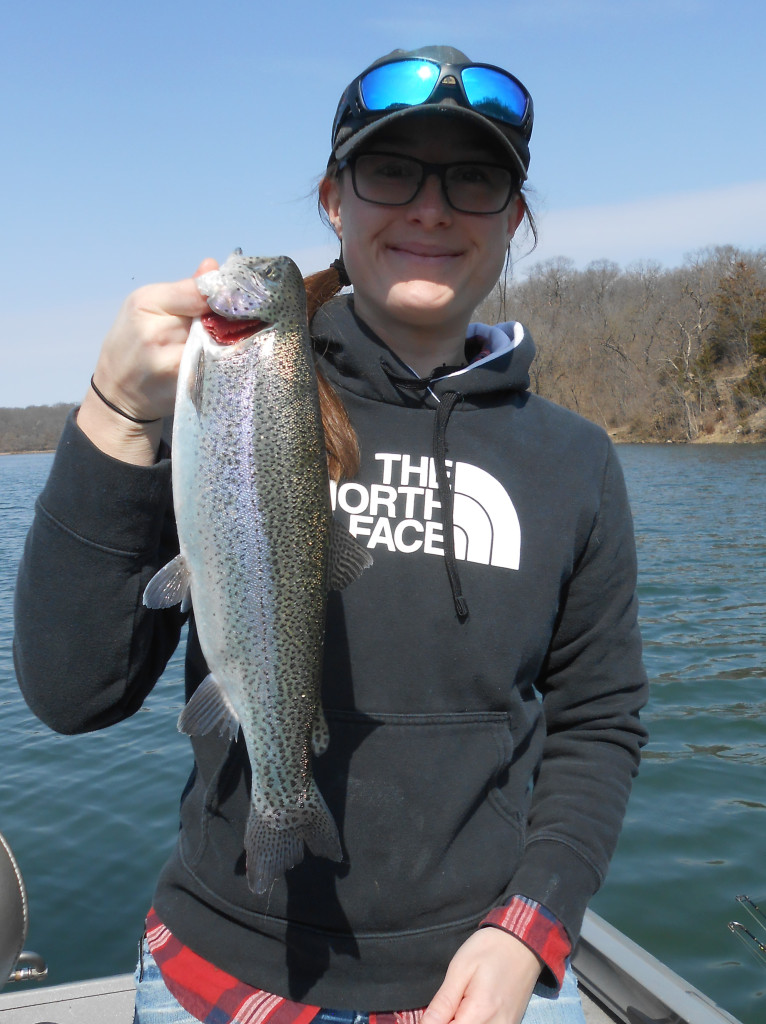
Four of the largemouth bass were caught on a Z-Man’s green-pumpkin Finesse ShadZ affixed to a chartreuse 1/32-ounce Gopher jig. Five largemouth bass were caught on a jerkbait. The other 101 largemouth bass were caught on a 2 1/2-inch Z-Man’s green-pumpkin-red ZinkerZ affixed to a red 1/16-ounce Gopher jig, a 2 1/2-inch Z-Man’s California craw ZinkerZ affixed to a black 1/16-ounce Bass Pro Shops’ Shroom Heads, and a three-inch Z-Man’s green-pumpkin prototype finesse creature bait affixed on a chartreuse 1/16-ounce Gopher jig.
The preponderance of the largemouth bass was caught while we were employing either a drag-and-subtle-shake presentation or a drag-and-deadstick retrieve. Some were caught on an extremely slow swimming presentation. A few were caught on the initial drop of our rigs. Several were caught when we were employing a swim-glide-and-subtle-shake presentation.
The bulk of the largemouth bass were caught in six to eight feet of water.
We caught 79 largemouth bass along a 100-yard stretch of a south shoreline and its adjacent coontail flat inside one of the seven feeder-creek arms that we fished. The underwater terrain of this shoreline and flat consists of gravel, rocks, boulders, and silt; portions of this terrain are adorned with patches of coontail and a brush pile or two. The water’s edge of the shoreline is stippled with several significant laydowns.
One rock-and-boulder-laden and relatively steep main-lake point yielded two largemouth bass. Another rock-and-boulder-laden and relatively steep main-lake point yielded four largemouth bass. We caught one largemouth bass along a flat and gravel-laden main-lake point that is enhanced with patches of coontail. We failed to elicit a strike at two rock-and-boulder-laden and relatively steep main-lake points.
We caught eight largemouth bass along the rocks and boulders that litter the dam, and some of those rocks and boulders are graced with patches of coontail.
Along the shorelines and on the flats inside the other six feeder-creek arms, we struggled to locate and catch 16 largemouth bass, and 11 of these were associated with patches of coontail. Five of them were associated with rocks and boulders. And there were many yards of shorelines and square yards of flats where we failed to elicit a strike.
Eight of the rainbow trout were caught along the dam. Six rainbow trout were caught along the shoreline inside the feeder-creek arm where we caught 79 largemouth bass. Five rainbow trout were caught along a north shoreline and its adjacent flat inside another feeder-creek arm. Two rainbow trout were caught on a coontail flat in the back of another feeder-creek arm.
One rainbow trout was caught on the Z-Man’s green-pumpkin Finesse ShadZ affixed to a chartreuse 1/32-ounce Gopher jig. Four rainbow trout were caught on the three-inch Z-Man’s green-pumpkin prototype finesse creature bait affixed on a chartreuse 1/16-ounce Gopher jig. The rest of them were caught on either the 2 1/2-inch Z-Man’s green-pumpkin-red ZinkerZ affixed to a red 1/16-ounce Gopher jig or the 2 1/2-inch Z-Man’s California craw ZinkerZ affixed to a black 1/16-ounce Bass Pro Shops’ Shroom Heads. The rainbow trout were caught on four of the standard Midwest finesse retrieves: a slow and straight swimming retrieve, a swim-glide-and-subtle-shake retrieve, drag-and-subtle-shake retrieve, and a drag-and-deadstick retrieve.
Mar. 8 log
Steve Reideler of Denton, Texas, filed a detailed log on the Finesse News Network about his Mar. 8 outing.
Here is an edited version of his log:
Norman Brown of Lewisville, Texas, and I fished at a U.S. Army Corps of Engineers’ hill-land reservoir in north-central Texas on Mar. 8. We relished fishing underneath a beautiful powder-blue sky that was decorated with a few wispy clouds. The radiant sun was warm and shining everywhere. The wind quartered out of the southeast at 15 to 20 mph. The barometric pressure measured 30.27 at 12:47 p.m. and dropped to 30.15 by 4:47 p.m.
In-Fisherman’s solunar calendar noted that the most productive fishing phases would occur from 12:44 a.m. to 2:44 a.m., 6:58 a.m. to 8:58 a.m., and 7:26 p.m. to 9:26 p.m. Norman and I were afloat from 1:30 p.m. to 5:00 p.m.
The water level was normal. The water was stained with about a foot of visibility. The water temperature ranged from 59 to 61 degrees.
We spent the entire 3 1/2 hours searching for pre-spawn largemouth bass inside three large coves on the south end of the reservoir. The underwater terrains inside these coves are composed of clay, rocks, gravel, and boulders. Most of the shorelines are steep and adorned with secondary points, tertiary points, a few shallow mud flats, several concrete boat ramps, and numerous covered boat docks. Remnants of a few patches of flooded terrestrial vegetation enhance a few stretches of the shorelines.
Overall, we enjoyed tangling with 24 largemouth bass, which is considered a good outing for north-central Texas in early March. The fishing, however, started off slow, and it took us about 45 minutes to cross paths with the first largemouth bass. The last hour was also trying as we struggled to catch two largemouth bass.
The first cove we fished relinquished 17 largemouth bass, and we caught them along the east side of this cove.
Eleven of those 17 largemouth bass were caught in 13 to 15 feet of water off the end of a rock-laden secondary point that lies in the middle of the cove. To counter the effects of the wind, we secured the boat to a covered boat dock that was in close proximity to the point and floated in 15 feet of water. All of these largemouth bass were caught on either a 2 1/2-inch Z-Man’s pumpkin-chartreuse ZinkerZ affixed on a chartreuse 1/16-ounce Gopher jig or a 2 1/2-inch Z-Man’s coppertreuse ZinkerZ rigged on a chartreuse 1/16-ounce Gopher jig. Both of these ZinkerZ rigs were employed with a drag-and-shake retrieve down the slope of the point.
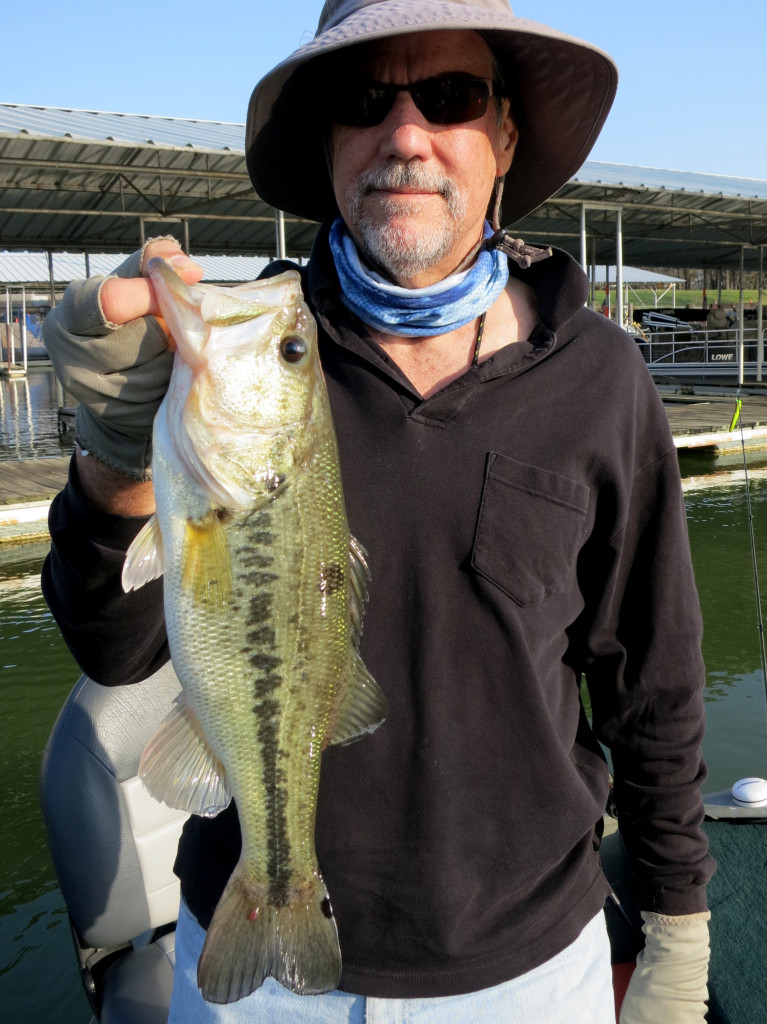
Six of the 17 largemouth bass were caught in nine to 13 feet of water, and they were situated about 15 to 20 feet away from the water’s edge along a steep shoreline that is adjacent to the secondary point that yielded 11 largemouth bass. We kept the boat close to the shoreline in two to four feet of water and made our casts into the deeper water. Four bass were caught on the 2 1/2-inch pumpkin-chartreuse ZinkerZ and the 2 1/2-inch coppertreuse ZinkerZ rigs. The other two were caught on a shortened Z-Man’s black-blue-flake Hula StickZ rigged on a blue 1/16-ounce Gopher jig, and these two bass were the only ones we could allure with this combo. These bass preferred a swim-glide-and-shake presentation rather than the drag-and-shake presentation across the bottom. We also elicited a couple of strikes that we failed to hook.
The second cove was not as fruitful as the first one. It yielded five largemouth bass. They were caught in five to 13 feet of water from two secondary points on the east side of the cove. Two of the five were caught along a boulder-laden and flat secondary point near the mouth of the cove on the 2 1/2-inch coppertreuse ZinkerZ and a swim-glide-and-shake retrieve. Three largemouth bass were caught in 11 to 13 feet of water from a rocky secondary point about halfway inside the cove on the coppertreuse ZinkerZ and drag-and-shake presentation along the downward slope of the point. One was caught on the 2 1/2-inch pumpkin-chartreuse ZinkerZ implemented with a a slow swim-glide-and-shake retrieve.
The third cove surrendered two largemouth bass. They were caught along the west shoreline in less than five feet of water. One was caught on the 2 1/2-inch pumpkin-chartreuse ZinkerZ, and the other one was caught on the 2 1/2-inch coppertreuse ZinkerZ. Both of these rigs were employed with a slow swim-glide-and-shake retrieve. We failed to garner any strikes with a slow drag-and-shake presentation.
In sum, the bulk of these largemouth bass were relating to the deep-water ends of three rocky secondary points in 11 to 15 feet of water in the middle sections of the coves. A few were associated with the steeper shorelines adjacent to the secondary points in nine to 13 feet of water. Twenty-two of the 24 largemouth bass were caught about 20 to 40 feet from the water’s edge. The east shorelines of the coves were more fruitful than the west shorelines. The shallow mud flats, covered boat docks, and the back ends of the coves were devoid of bass. Only two bass were caught near the mouths of the coves. We did not fish around any of the boat ramps.
It appears to us that it may take another week or two of warm weather before the water warms into the low 60s, which is when we typically find largemouth bass engaging in some of their spawning rituals in the back ends of these coves.
Mar. 9 log
The Weather Underground reported that it was 33 degrees at 6:53 a.m., 68 degrees at 12:53 p.m., and 60 degrees at 3:53 p.m. The wind was calm at times, and at other times, it angled out of the north by northwest, southeast, north, northeast, and north by northeast at 3 to 13 mph. The sky was clear for a long spell, and then in the afternoon, it fluctuated from being scattered with clouds to being mostly cloudy to being overcast. The barometric pressure was 30.06 at 12:53 a.m., 30.04 at 5:53 a.m., 29.97 at 11.53 a.m., and 30.00 at 2:53 p.m. While we were afloat, a significant series of thunderstorms and hail storms walloped the southern portions of northeastern Kansas and traversed into western Missouri.
In-Fisherman’s solunar calendar indicated that the best fishing on Mar. 9 would take place from 7:41 a.m. to 9:41 a.m., 8:08 p.m. to 10:08 p.m., and 1:28 a.m. to 3:28 a.m.
From 10:20 a.m. to 2:20 p.m., Dave Petro of Lecompton, Kansas, and I went bass fishing for trout at one of northeastern Kansas’ community reservoirs. And it was a task for us to catch 26 largemouth bass and two rainbow trout. Twenty of those 26 were caught in 89 minutes, and then we fished for 151 minutes and struggled to catch six largemouth bass.
The water level was normal. The water clarity exhibited seven to eight feet of visibility. The surface temperature ranged from 51 to 53 degrees. But another angler reported that his boat’s thermometer recorded the surface temperature at 50 degrees. We were able to find only one area that was adorned with submerged aquatic vegetation, which is on a shallow-water flat about 75 percent of the way inside a feeder-creek arm. These patches of aquatic vegetation consisted of several patches of sickly-looking Eurasian milfoil, and some of those patches were partially covered with filamentous algae.
While we were fishing six main-lake points, 50-yards of the dam, and portions of two main-lake shorelines, we failed to elicit a strike.
We fished portions of seven shorelines inside four feeder-creek arms. And we failed to elicit a strike along one of these shorelines.
Along the south shoreline inside one feeder-creek arm, two largemouth bass and one rainbow trout were caught in four to seven feet of water. The underwater terrain of this shoreline consists of gravel, rocks, and boulders. The slope of the terrain is about a 45-degree grade. The water’s edge is graced with an array of laydowns and several patches of American water willows. A three-inch Z-Man’s green-pumpkin prototype finesse creature bait affixed to a chartreuse 1/16-ounce Gopher jig that was strolled with a drag-and-subtle-shake presentation caught one of the largemouth bass. A 2 1/2-inch Z-Man’s pumpkin-chartreuse ZinkerZ affixed to a chartreuse 1/15-ounce Z-Man’s ShroomZ Finesse jig that was strolled with a straight dragging retrieve caught one largemouth bass and the rainbow trout.
Along the south shoreline and around one of its tertiary points inside another feeder-creek arm, we caught four largemouth bass in three feet of water. The underwater terrain of this shoreline consists of gravel, rocks, and boulders. The slope of the terrain varies from a 35- to a 40-degree grade. The water’s edge is embellished with patches of American water willows. Along this shoreline, there are three manmade brush piles that are anchored in eight to 12 feet of water. Three of the largemouth bass were caught on the three-inch Z-Man’s green-pumpkin prototype finesse creature bait affixed to a chartreuse 1/16-ounce Gopher jig. One of those three was caught on the initial drop of that rig, and the other two were caught on a drag-and-subtle-shake presentation. One largemouth bass was caught on a 2 1/2-inch Z-Man’s mud minnow Hula StickZ affixed to a chartreuse 1/15-ounce Z-Man’s ShroomZ Finesse jig with a swim-glide-and-no-shake presentation. Along the north shoreline of this feeder-creek arm, we caught one largemouth bass around a laydown on the initial drop of the mud minnow Hula StickZ rig. The makeup of this shoreline is similar to the south one.
Inside the fourth feeder-creek arm that we fished, we caught eight largemouth bass in four to eight feet of water along a 150-yard stretch of one of its north shorelines. The underwater terrain of this shoreline consists of gravel, rocks, and boulders. The slope of the terrain varies from a 30- to a 45-degree grade. Portions of the water’s edge are embellished with patches of American water willows and 10 laydowns. There are several manmade brush piles that are anchored in 10 to 14 feet of water. Four of the largemouth bass were caught on the three-inch Z-Man’s green-pumpkin prototype finesse creature bait affixed to a chartreuse 1/16-ounce Gopher jig that was strolled with a drag-and-deadstick presentation. Two were caught on a 2 1/2-inch Z-Man’s pumpkin-chartreuse ZinkerZ affixed to a chartreuse 1/15-ounce Z-Man’s ShroomZ Finesse jig that was strolled with a straight dragging presentation. One largemouth bass was caught on a Z-Man’s California craw Finesse T.R.D. affixed to a red 1/16-ounce Gopher jig that was strolled with a straight dragging presentation. One bass was caught on a Z-Man’s green-pumpkin Finesse ShadZ on a red 1/16-ounce Gopher jig that was strolled with a drag-and-deadstick retrieve.Along a 75-yard stretch of another north shoreline inside the fourth feeder-creek arm, we caught six largemouth bass and one rainbow trout in three to four feet of water. The underwater terrain of this shoreline consists of gravel, rocks, and silt. The slope of its terrain is about a 20-degree grade. The water’s edge is lined with riprap and patches of American water willows. This shoreline borders a shallow-water flat that is stippled with some paltry patches of Eurasian milfoil, and there were bits of Eurasian milfoil adjacent to the outside edge of some of the patches of American water willows. Four of the largemouth bass and the rainbow trout were caught on the three-inch Z-Man’s green-pumpkin prototype finesse creature bait affixed on a chartreuse 1/16-ounce Gopher jig that was strolled with a drag-and-deadstick presentation. One largemouth bass was caught on the 2 1/2-inch Z-Man’s pumpkin-chartreuse ZinkerZ affixed to a chartreuse 1/15-ounce Z-Man’s ShroomZ Finesse jig that was strolled with a straight dragging presentation.
Along a 75-yard stretch of another north shoreline inside the fourth feeder-creek arm, we caught six largemouth bass and one rainbow trout in three to four feet of water. The underwater terrain of this shoreline consists of gravel, rocks, and silt. The slope of its terrain is about a 20-degree grade. The water’s edge is lined with riprap and patches of American water willows. This shoreline borders a shallow-water flat that is stippled with some paltry patches of Eurasian milfoil, and there were bits of Eurasian milfoil adjacent to the outside edge of some of the patches of American water willows. Four of the largemouth bass and the rainbow trout were caught on the three-inch Z-Man’s green-pumpkin prototype finesse creature bait affixed on a chartreuse 1/16-ounce Gopher jig that was strolled with a drag-and-deadstick presentation. One largemouth bass was caught on the 2 1/2-inch Z-Man’s pumpkin-chartreuse ZinkerZ affixed to a chartreuse 1/15-ounce Z-Man’s ShroomZ Finesse jig that was strolled with a straight dragging presentation.
Along a 50-yard stretch of one of the south shorelines inside the fourth feeder-creek arm, we caught five largemouth bass in three to six feet of water. The underwater terrain of this shoreline consists of gravel, rock, and boulders. The slope of the terrain was about 40 degrees. The water’s edge has one minor laydown, two significant laydowns, and four scrawny American water willow patches. Four of the largemouth bass were caught on the three-inch Z-Man’s green-pumpkin prototype finesse creature bait affixed on a chartreuse 1/16-ounce Gopher jig with a swim-glide-and-shake presentation. One of the five largemouth bass was caught on a 2 1/2-inch Z-Man’s California craw ZinkerZ affixed to a red 1/32-ounce Gopher jig with a swim-glide-and-shake presentation.
After we spent four arduous hours bass fishing for trout, I was ready to head home. But Dave said he wanted to try to fish for trout with his standard Kansas trout tactics, and I said I would join him for another 30 minutes or so. As Dave pursued the trout, he wielded a tiny trout spoon, and I used a Z-Man’s bubble gum Finesse T.R.D. affixed to a red 1/16-ounce Gopher jig. Ultimately, we spent about 45 minutes dissecting the shallow-water flat and portions of its adjacent shorelines in the back of the fourth feeder-creek arm. During the final 10 minutes, Dave switched to a Z-Man’s bubble gum Finesse T.R.D. affixed to a red 1/16-ounce Gopher jig, too. Periodically, I made a few casts and retrieves with the three-inch Z-Man’s green-pumpkin prototype finesse creature bait affixed on a chartreuse 1/16-ounce Gopher jig. Our bubble gum Finesse T.R.D. rigs caught three rainbow trout. Those rigs also elicited 10 strikes that we failed to hook, and we hooked two rainbow trout that liberated themselves before we could lift them across the gunnels of Dave’s boat. What’s more, we inadvertently caught seven largemouth bass. The three rainbow trout and four of the largemouth bass were caught as we were employing either a drag-and-deadstick retrieve or a swim-glide-and-subtle-shake retrieve with our bubble gum Finesse T.R.D. rigs in four to six feet of water. Three of the largemouth bass were caught on the prototype finesse creature bait with a swim-glide-and-subtle-shake retrieve.
To my chagrin, this prototype is on its last leg, and there are no more to be had.
Mar. 10 log
Steve Reideler of Denton, Texas, filed a log on the Finesse News Network about his Mar. 10 outing.
Here is an edited version of his log:
I joined Rick Allen of Dallas at a U.S. Army Corps of Engineer’s hill-land reservoir in north-central Texas.
This reservoir was our most fruitful one in 2015, and it was fruitful until November of 2016. Since then, the black bass fishing has been problematic. For instance, on Nov. 13, 2016, the fishing became so trying and exasperating that I eked out only six black bass in three hours. Consequently, I did not return to this impoundment again until March 3, 2017, when I endured another horrid outing and caught only nine largemouth bass in three hours.
The Weather Underground noted that the morning low on March 10 was 57 degrees and the afternoon high was 71 degrees. The sky was overcast throughout the morning and became partly cloudy by 3:00 p.m. The wind was a nuisance as it angled out of the north and northwest at 14 to 16 mph. The barometric pressure was 30.27 at 10:00 a.m. and 30.15 at 4:00 p.m.
The water was mostly stained with about a foot of visibility. The surface temperature varied from 57 degrees on the main lake to 63 degrees in the back end of a feeder-creek arm. The water level was normal.
In-Fisherman’s solunar calendar listed the most productive fishing periods occurring from 2:21 a.m. to 4:21 a.m., 8:34 a.m. to 10:34 a.m., and 9:00 p.m. to 11:00 p.m. Rick and I fished from about 10:30 a.m. to 4:00 p.m.
Our undertaking began at the dam, which forms the east perimeter of the impoundment. The water temperature was 57 degrees. Rick and I spent 80 minutes dissecting the many yards of the dam’s riprap, and we caught three largemouth bass that were abiding in three to eight feet of water. We hooked another largemouth bass that was able to pull free before we could land it. Two of the largemouth bass were caught on a shortened Z-Man’s black-blue-flake Hula StickZ affixed to a blue 1/16-ounce Gopher jig, and one was caught on a shortened four-inch Z-Man’s black-blue Finesse WormZ rigged on a blue 1/16-ounce Gopher jig. These baits were employed with a slow swim-glide-and-shake retrieve.
After we fished the dam, we ventured inside a feeder-creek arm that lies just west of the dam on the southeast end of the reservoir.
This feeder-creek arm contains a large marina, several rocky and steep shorelines, five coves, 10 secondary points, and a bridge. The water temperature was 57 degrees.
We plied several secondary points, a small cove, a small submerged rock ledge underneath the west end of the bridge, and a couple of the steep shorelines. We hooked one largemouth bass on the shortened black-blue-flake Hula StickZ rig in four feet of water along a rocky secondary point in the midsection of the creek arm, but it was able to break the line on a submerged obstruction. We also elicited a couple of strikes at two other secondary points that we failed to hook.
After that, we traveled to another feeder-creek arm, which is located on the north end of the reservoir. This feeder creek splits into two arms. The east arm features a large marina, an island, several rocky secondary points, two bluff-like shorelines, several coves, and two steep shorelines with a submerged creek channel that courses next to them. The water temperature ranged from 59 degrees at the mouth of this feeder creek to 63 degrees inside a small cove in the northern region of the east creek arm. The west arm is similar to the east one, but it does not contain a marina or an island. We concentrated our efforts in the east arm.
We caught 14 largemouth bass inside this feeder-creek arm. One bluff-like shoreline yielded three largemouth bass that were caught in five to eight feet of water and many yards apart from each other. Another largemouth bass was caught from the north side of the island in six feet of water. A secondary point at the mouth of a cove in the middle of the creek arm relinquished three largemouth bass that were abiding in four to nine feet of water. Three largemouth bass were caught along one of the two steep creek-channel shorelines, and three more largemouth bass were caught from the other steep creek-channel shoreline. These six largemouth bass were caught in five to 11 feet of water. The fourteenth largemouth bass was caught in five feet of water next to a patch of flooded terrestrial vegetation inside a small cove on the north end of the creek arm.
Twelve bass were caught on the shortened black-blue Hula StickZ rig and slow swim-glide-and-shake retrieve. One largemouth bass was caught on a 2 1/2-inch Z-Man’s pumpkin-chartreuse ZinkerZ affixed on a chartreuse 1/16-ounce Gopher jig. One largemouth bass was caught on a 2 1/2-inch Z-Man’s black-blue ZinkerZ rigged on a blue 1/16-ounce Gopher jig. These rigs were employed with a slow swim-glide-and-shake presentation or a slow drag-and-shake presentation.
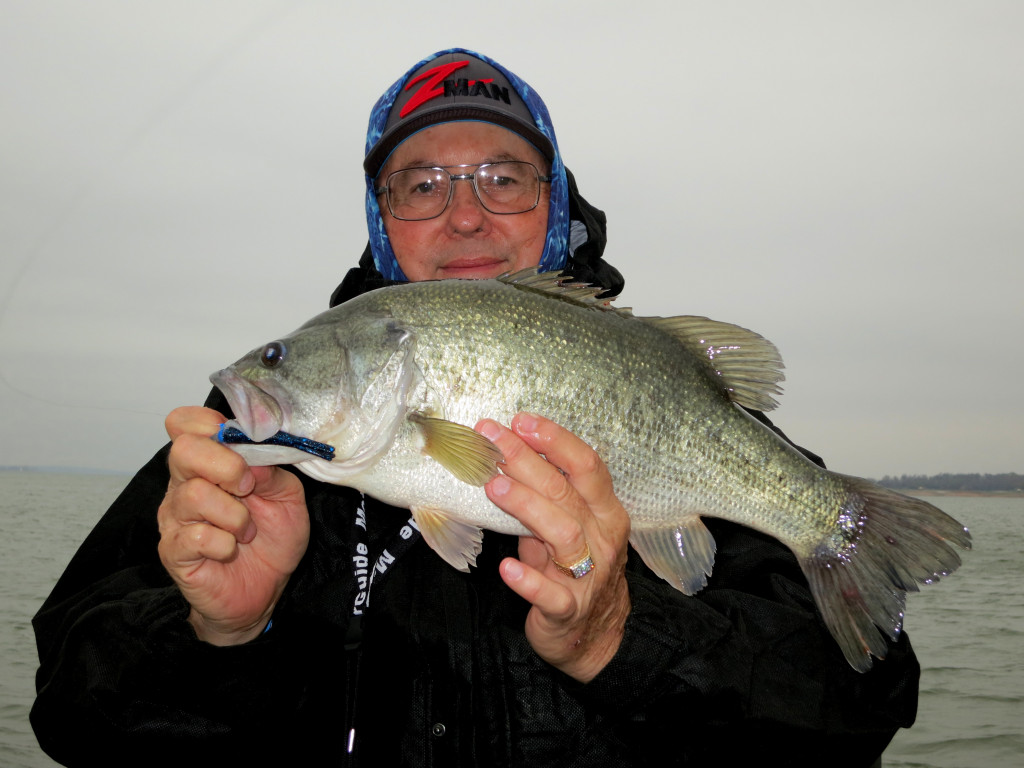
We spent about 30 minutes vertically fishing jigging spoons around a large school of fish that we were unable to identify. This large school of fish was dwelling near the bottom of the main creek channel in 35 feet of water, and we failed to generate any strikes with the jigging spoons.
Fifteen of the largemouth bass weighed between 1 1/4 pounds and 2 3/4 pounds. Two largemouth bass were under 12 inches in length. The heftiest one weighed four pounds, six ounces.
Mar. 13 log
Steve Reideler of Denton, Texas, filed a log on the Finesse News Network about his Mar. 13 outing.
Here is an edited version of his log:
A cold front and a couple of rain storms passed through the Dallas and Ft. Worth metropolitan areas during the early morning hours of March. 13. But the rain did not deter Mike Trometer of Plano, Texas, and me from introducing him to the many virtues of Midwest finesse tactics at a U.S. Army Corps of Engineers’ hill-land reservoir in north-central Texas.
The Weather Underground reported that it was 50 degrees at 7:00 a.m. and 64 degrees at 4:00 p.m. After the rain moved off to the southeast, the sky remained overcast until 2:00 p.m., and then it became partly cloudy. A robust wind angled out of the north at 16 to 22 mph. The barometric pressure measured 30.18 at 10:00 a.m. and 30.16 at 4:00 p.m.
The best fishing periods, according to In-Fisherman’s solunar calendar, would take place from 5:43 a.m. to 7:43 a.m., 11:31 a.m. to 1:31 p.m., and 11:54 p.m. to 1:54 a.m. Mike and I fished from about 11:00 a.m. to 3:00 p.m.
The water was stained with about 1 1/4 feet of visibility. The water level was normal. The water temperature ranged from 59 to 60 degrees.
We tried to hide from the wind inside three large coves. Each of these coves contains a large marina. The shorelines and underwater terrains of these coves consist of red clay, gravel, fist-size rocks, and boulders. The shorelines are steep.
We caught 11 largemouth bass and lost two others along the east side of the first cove. Eight of them were abiding in three to five feet of water along two steep clay and gravel shorelines. Five of these eight largemouth bass were caught on a 2 1/2-inch Z-Man’s coppertreuse ZinkerZ affixed to a chartreuse 1/16-ounce Gopher jig. Two were caught on a shortened Z-Man’s green-pumpkin Hula StickZ affixed to a chartreuse 1/16-ounce Gopher jig, and one was caught on a 2 1/2-inch Z-Man’s pumpkin-chartreuse ZinkerZ affixed to a chartreuse 1/16-ounce Gopher jig. All three of these lures were employed with a slow swim-glide-and-shake presentation.
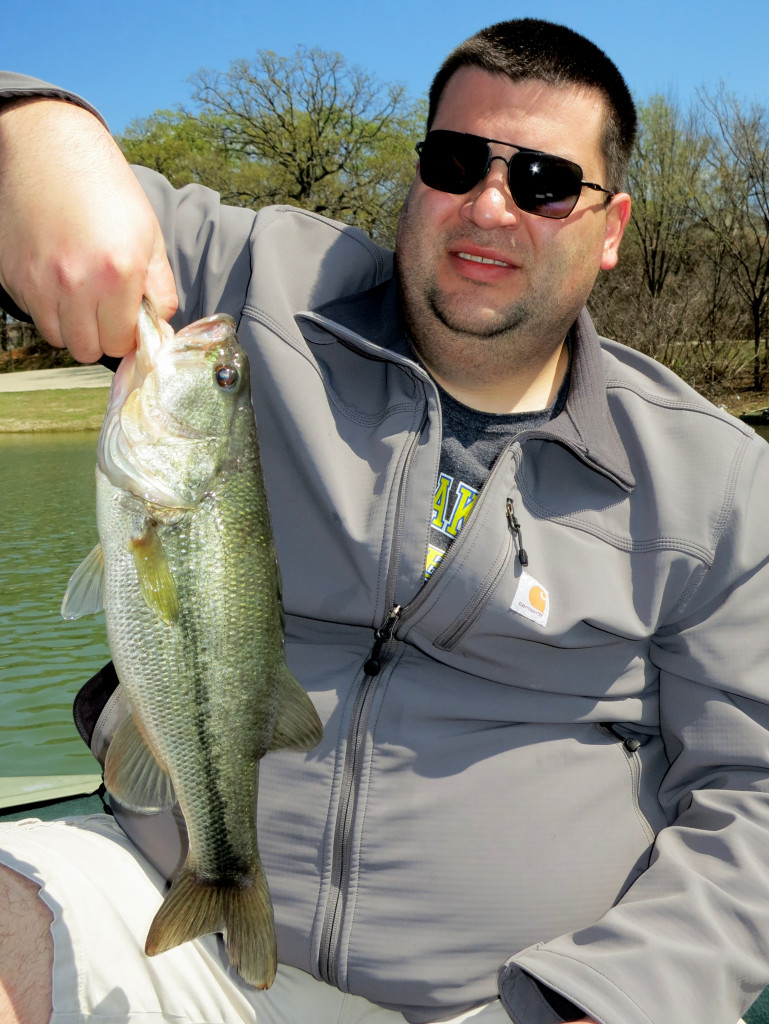
Three largemouth bass were caught in 15 feet of water off the end of a rock-laden secondary point. These three largemouth bass were caught on the 2 1/2-inch Z-Man’s coppertreuse ZinkerZ affixed to a chartreuse 1/16-ounce Gopher jig, which was presented with a slow drag-and-shake retrieve.
We failed to elicit any strikes from several of the covered boat docks, three prominent secondary points, and two mud flats located on the west and south sides of the cove.
The second cove yielded eight largemouth bass. Six of these largemouth bass were caught in three to five feet of water from three secondary points on the east side of the cove. One was caught from a clay and silt-laden flat just north of the three secondary points. One largemouth bass was caught from a steep clay and gravel shoreline on the west side of the cove. They were caught on the 2 1/2-inch coppertreuse ZinkerZ rig and swim-glide-and-shake retrieve. We failed to elicit any strikes with the shortened green-pumpkin Hula StickZ rig.
The third cove surrendered only one largemouth bass. This bass was caught from a steep west-side shoreline in less than five feet of water. It was caught on the 2 1/2-inch coppertreuse ZinkerZ rig as it was being retrieved with a slow swim-glide-and-shake presentation.
In sum, it was a chore for us to catch 20 largemouth bass. But this trying endeavor gave Mike the opportunity to see the effectiveness of Midwest finesse tactics in adverse conditions.
Mar. 16 log
Until Mar. 16, Old Man Winter and Mother Nature’s windy ways had kept me at bay since Mar. 9. For instance, area thermometers plummeted to 17 degrees on Mar. 14 and 15. The wind howled at 24 mph on Mar. 10 and 33 mph on Mar. 13. It snowed on Mar. 11 and Mar. 14.
It was windy on Mar. 16, but it was warm. The warm weather provoked my old bones to get afloat.
The Weather Underground reported that it was 30 degrees at 7:52 a.m. and 71 degrees at 4:52 p.m. It was sunny most of the time, but there was a brief spell when the sky became overcast. The wind angled out of the east, east by southeast, south by southeast, southeast, and south at 6 to 27 mph. The barometric pressure was 30.28 at 12:52 a.m., 20.19 at 5:52 a.m., 30.09 at 11:52 a.m., and 29.98 at 2:52 p.m.
In-Fisherman’s solunar calendar indicated that the best fishing would occur from 1:51 a.m. to 3:51 a.m., 2:13 p.m. to 4:13 p.m., and 8:02 a.m. to 10:02 a.m. I was afloat at one of northeastern Kansas’ community reservoirs from 10:46 a.m. to 2:46 p.m.
The water level at this reservoir looked to be a tad below normal. The water exhibited about 2 1/2 feet of visibility. The surface temperature ranged from 44 degrees to 48 degrees. (It is interesting to note that the surface temperature at one of the nearby community reservoirs that Dave Petro of Lecompton, Kansas, and I fished on Mar. 9 hit a high temperature of 53 degrees.)
I fished about 120 feet of one wind-blown main-lake shoreline, and I failed to elicit a strike. I used a mega drift sock and tried to fish a shoreline along the east side of a feeder-creek arm, where I failed to garner a strike.
During the rest of the outing, I hid from the wind inside three feeder-creek arms and focused on dissecting five shorelines. And I caught 43 largemouth bass.
The underwater terrains of these shorelines consist of gravel and rocks, and some portions are littered with boulders. Some of the boulders are humongous. There are also a couple of terrains that consist of a bit of silt and sand. A few sections of the shorelines have a 45- to 60-degree slope, and other sections have a 20- to 30-degree slope. The water’s edge along many yards of these shorelines are graced with patches of winter-dead American water willows, as well as some laydowns, stumps, beaver huts, and brush piles. Some of these shorelines and adjacent flats are endowed with patches of curly-leaf pondweed that are covered with four to seven feet of water. Four of the five shorelines are cluttered with a few docks. There are several concrete and rock retaining walls along three of the shorelines.
The steep shorelines failed to yield a strike.
I spent two hours fishing portions of the north and south shorelines inside one feeder-creek arm. I caught 18 largemouth bass along the north shoreline and four largemouth bass along the south shoreline. I also garnered five strikes that I failed to hook, and I hooked a fish that liberated itself during a vigorous 30-second donnybrook.
I fished about 300 yards of the north shoreline. Thirteen of the largemouth bass that I caught along the north shoreline were abiding in five to 10 feet of water along a 75-yard stretch of this shoreline. The other five largemouth bass were caught hither-and-yon in four to 10 feet of water. All of them were caught from about 10 to 20 feet from the water’s edge.
I fished about 300 yards of the south shoreline, and the four largemouth bass that I caught were abiding in three to six feet of water, and they were 30 to 50 yards apart. They were caught from five to 15 feet from the water’s edge.
I spent 14 minutes dissecting a 40-yard section of a north shoreline inside another feeder-creek arm. And I caught three largemouth bass adjacent to the outside edge of a winter-dead patch of American water willows in four to five feet of water.
The rest of the outing was spent slowly fishing a 90-yard stretch along the south shoreline and 350-yard stretch of the north shoreline inside another feeder-creek arm.
I caught 11 largemouth bass along the north shoreline, and they were caught in six to 11 feet of water and 15 to 25 feet from the water’s edge.
I caught seven largemouth bass along the south shoreline in four to five feet of water. Six were caught adjacent to a laydown, and one was caught along a deteriorated concrete and rock retaining wall.
One of the 43 largemouth bass was caught on a Z-Man’s green-pumpkin Finesse ShadZ affixed to a red 1/16-ounce Gopher jig. Five largemouth bass were caught on a 2 1/2-inch Z-Man’s Junebug ZinkerZ affixed to a chartreuse 1/16-ounce Gopher jig. Seven largemouth bass were caught on a tattered-and-torn three-inch Z-Man’s green-pumpkin finesse creature bait affixed to a chartreuse 1/16-ounce Gopher jig. Thirty largemouth bass were caught on a 2 1/2-inch Z-Man’s California craw ZinkerZ affixed to a red 1/16-ounce Gopher jig.
Two of the largemouth bass were caught on the initial drop of the Z-Man’s California craw ZinkerZ rig. The bulk of the 43 largemouth bass were caught while I was strolling and employing a drag-and-deadstick presentation. Some were caught while I was casting and employing a swim-glide-and-subtle-shake retrieve.
Mar. 17 log
The Weather Channel reported that it was 54 degrees at 7:53 a.m. and 72 degrees at 3:53 p.m. The wind angled out of the south, southwest, west by southwest, west, west by northwest, north, north by northeast, and north by northwest at 3 to 24 mph. The sky fluctuated from being clear to mostly cloudy to overcast to partly cloudy to sunny. The barometric pressure was 29.83 at 12:53 a.m., 29.93 at 5:53 a.m., 30.09 at 11:53 a.m., and 30.10 at 2:53 p.m.
In-Fisherman’s solunar calendar indicated that the best fishing would occur from 2:56 a.m. to 4:56 a.m., 3:18 p.m. to 5:18 p.m., and 9:07 a.m. to 11:07 a.m.
Rick Hebenstreit of Shawnee, Kansas, and I journeyed to one of northeastern Kansas’ community reservoirs, where we bass fished for trout. We made our first casts at 10:36 a.m. and our last ones at 2:36 p.m.
The surface temperature ranged from 46 to 48 degrees. The water clarity at most locales exhibited more than five feet of visibility, but along one wind-blown shoreline, the visibility was about 12 inches. The water level looked to be normal.
We fished two main-lake points and about 125 yards along a steep main-lake shoreline, where we failed to elicit a strike. At another main-lake locale, we also failed to garner a strike along a submerged rock fence.
We fished all of the shorelines inside one small feeder-creek arm, and we caught seven largemouth bass and one rainbow trout in two to nine feet of water. The underwater terrain consists of gravel and rocks. The water’s edge is lined with patches of winter-dead American water willows and a few laydowns. There are also several man-made brush piles in eight to 10 feet of water in close proximity to the shorelines. The shorelines have a 20- to 30-degree slope. Five of the largemouth bass were caught while we were strolling and employing a drag-and-deadstick presentation. Two of the largemouth bass were caught while we were employing a swim-glide-and-subtle-shake retrieve. The rainbow trout was caught while we were strolling and using a drag-and-deadstick presentation.
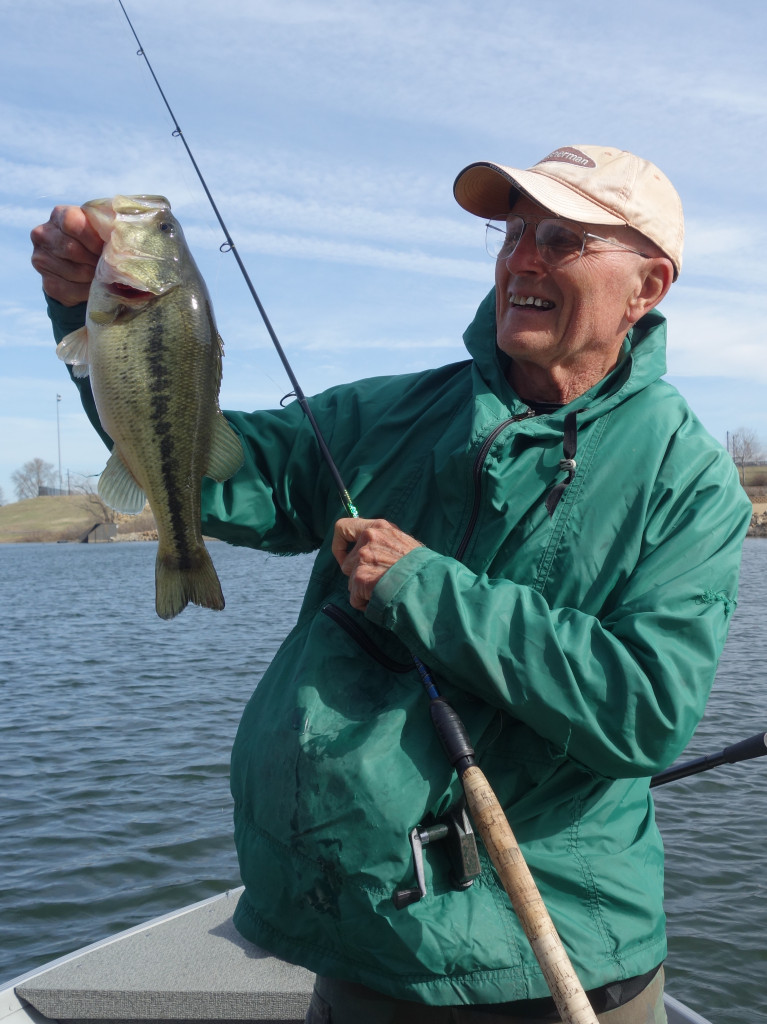
We fished two secondary points, 60 yards of the south shoreline, and portions of the shallow-water flat inside another small feeder-creek arm. The underwater terrain consists of gravel, rocks, and silt. Portions of the shoreline are embellished with winter-dead American water willows. The shoreline has a 20-degree slope. We caught four largemouth bass and 14 rainbow trout in four to six feet of water. The largemouth bass were caught along the shoreline. The rainbow trout were caught on the flat and along the shoreline. Three of the largemouth bass were caught while we were strolling with a drag-and-deadstick presentation. One largemouth bass was caught on a swim-glide-and-subtle-shake retrieve. Most of the rainbow trout were caught on a swim-glide-and shake presentation, and few were caught while we were strolling and employing a drag-and-deadstick retrieve.
We fished about 200-yards of the south shoreline inside another feeder-creek arm. The underwater terrain consists of gravel, rocks, and boulders. The water’s edge is adorned with several patches of winter-dead American water willows and scores of laydowns. The shoreline has a 40- to 45-degree slope. We caught 11 largemouth bass and one rainbow trout in three to nine feet of water. Three of the largemouth bass were caught on the initial drop of our baits. The others were caught while we were executing either a drag-and-deadstick presentation or a swim-glide-and-subtle-shake presentation. The rainbow trout was caught while we were strolling with a drag-and-deadstick retrieve.
We fished about 100 yards of a north shoreline inside another feeder creek arm. This shoreline has a 20-degree slope. Its water’s edge is lined with winter-dead American water willows, a few laydowns, and a beaver hut. Its underwater terrain consists of gravel, rocks, and silt. We caught one largemouth bass in about four feet of water on a swim-glide-and-subtle-shake retrieve.
We quickly fished about a 60-yard stretch of a shoreline inside a small feeder-creek arm, where we failed to elicit a strike. But we saw an angler who was walking the shoreline catch a largemouth bass at this shoreline’s main-lake point.
We spent 76 minutes inside another feeder-creek arm. We fished two secondary points, a 150-yard stretch of one of its north shorelines, another 75-yard stretch of one of its north shorelines, and a 35-yard stretch of one its south shorelines.
The secondary points were fruitless.
The 150-yard stretch of one of its north shorelines has a 35- to 40-degree slope. Its underwater terrain consists of gravel, rocks, and a few boulders. The water’s edge is graced with occasional patches of winter-dead American water willows, many laydowns, and several man-made brush piles in 10 to 12 feet of water. There are also two docks. We caught two largemouth bass and one rainbow trout in five to seven feet of water while we were employing an extremely slow swim-glide-and-subtle-shake presentation.
The 75-yard stretch of one of its north shorelines has a 15- to 20-degree slope. Its underwater terrain consists of gravel, rocks, and silt. The water’s edge is lined with riprap and winter-dead patches of American water willows. We caught two largemouth bass in five feet of water by strolling and using a drag-and-deadstick presentation.
The 35-yard stretch of one of its south shorelines has a 45-degree or more slope. Its underwater terrain consists of clay, gravel, rocks, a few boulders, and silt. The water’s edge is graced by two laydowns and a scrawny patch of winter-dead American water willows. Along this shoreline, we caught 15 largemouth bass and seven rainbow trout in four to nine feet of water. Two of the largemouth bass were caught on the initial drop of our rigs. The other 13 largemouth bass were caught while we were working with either a drag-and-deadstick presentation or a slow swim-glide-and-subtle-shake presentation; some were caught while we were casting, and some were caught while we were strolling. The rainbow trout were caught with the same presentations that we used to catch the largemouth bass.
In total, we caught 43 largemouth bass and 24 rainbow trout. We inadvertently caught two freshwater drum, one black crappie, and one white bass. We estimated that we garnered slightly more than two dozen strikes that we failed to hook, and we suspected that the bulk of those were rainbow trout strikes.
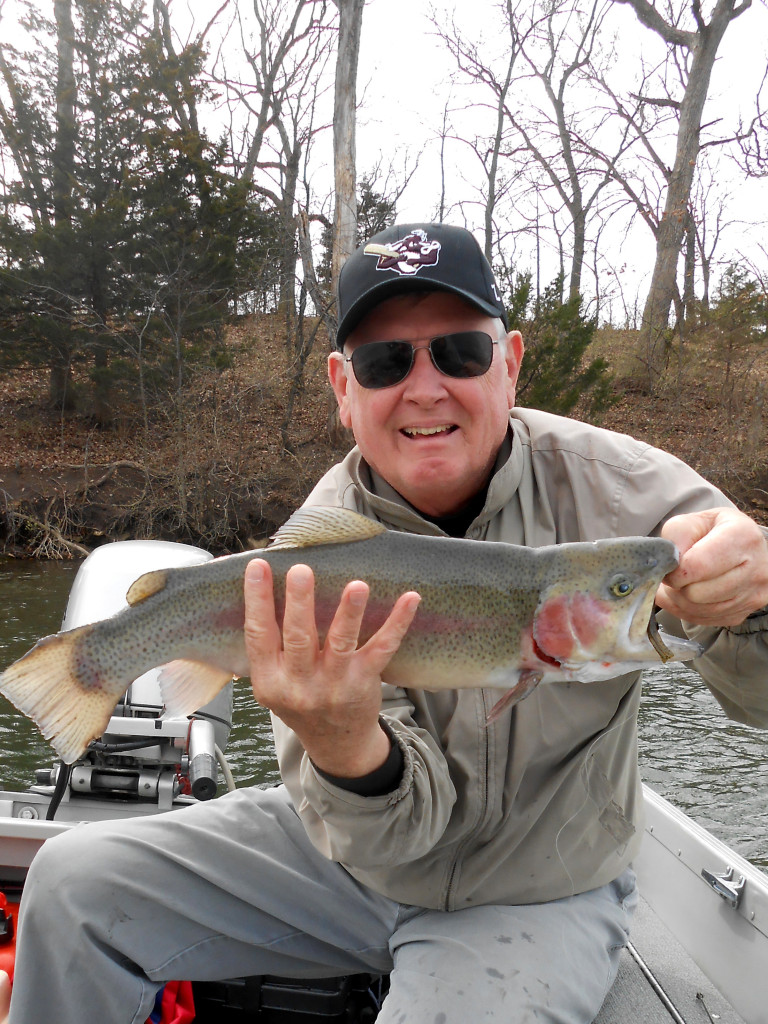
We caught one rainbow trout on a Z-Man’s green-pumpkin Finesse ShadZ affixed to a red 1/16-ounce Gopher jig. We caught one rainbow trout on a two-inch YUM green-pumpkin Wooly Beavertail affixed to a chartreuse 1/16-ounce Gopher jig. We caught five rainbow trout on a Z-Man’s bubble-gum Finesse T.R.D. on a red 1/16-ounce Gopher jig. We caught six largemouth bass on a 2 1/2-inch Z-Man’s California craw ZinkerZ affixed to a red 1/16-ounce Gopher jig. We caught 20 largemouth bass and five rainbow trout on a tattered-and-torn three-inch Z-Man’s green-pumpkin finesse creature bait affixed to a chartreuse 1/16-ounce Gopher jig. We caught 15 largemouth bass and 12 rainbow trout on a shortened Z-Man’s green-pumpkin Hula StickZ affixed to a chartreuse 1/16-ounce Gopher jig.
Mar. 18 log
Bob Gum of Kansas City, Kansas, posted a brief on the Finesse News Network about his Mar. 18 outing at one of northeastern Kansas’ power-plant reservoirs. He was joined by his wife, Yan, and their dog. Yan, however, spent her time studying and reading some scientific textbooks. (Yan works at the University of Kansas Medical Center. She is a dedicated biomedical scientist, and she would rather work than fish during the trying fishing days of March.)
Here is an edited version of his report:
The Weather Underground reported that it was 51 degrees at 6:53 a.m. and 68 degrees at 4:53 p.m. Between 12:53 a.m. to 11:53 p.m., the wind angled out of the north, north by northeast, northeast, east by northeast, east, southeast, and east by southeast at 5 to 10 mph, but it was brisker at this reservoir than it was reported on The Weather Underground’s site. The sky was clear from 12:53 a.m. to past 5:53 p.m. The barometric pressure was 30.28 at 12:53 a.m., 30.34…

